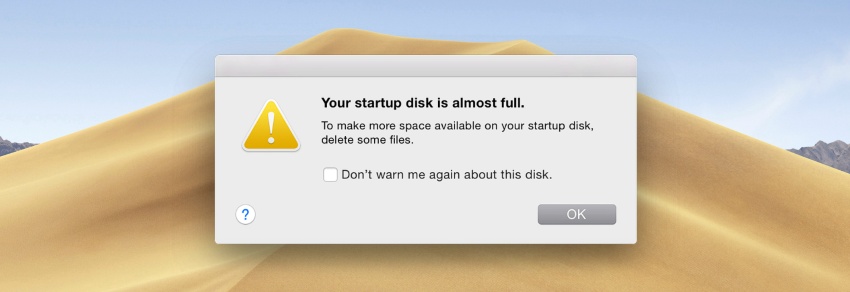
- #Mac os x startup disk no more space how to#
- #Mac os x startup disk no more space mac os#
- #Mac os x startup disk no more space free#
- #Mac os x startup disk no more space mac#
Step 4: Repeat the steps for other applications. Step 3: Now click on 'res' and get rid of the language you don't need on your Mac. Step 2: Choose 'show package contents' and click on 'contents'. Step 1: Head to applications and right-click on it. To get rid of language packs manually, perform the following steps: They might be using hundred of megabytes space for no reason.
#Mac os x startup disk no more space mac#
Mac applications have language files for every language. You can choose and delete it manually as per your needs. It will open a cache folder that consists of plenty of folders in it. There are tons of temporary files that you can check out by opening Finder and then go to Folder using ~/Library/Caches.
#Mac os x startup disk no more space free#
Removing them will not only speed up your system but also free up disk space.

MAC temporary files sometimes take up huge disk space.

Relax and wait for the tool to recover all the data deleted from the trash folder. It will scan and hunt for more files from trash deeply. If you are unable to find deleted files on Mac trash, use the All-Round Recovery option. Step 1: CTRL+click or right-click the 'Trash option' in that particular application If you have deleted files from them, you also need to empty their trash cans. Mail, iMovie, and iPhoto on Mac have their trash cans. It will delete all the files that you have moved to the trash from Finder. Step 1: CTRL-Click or right click on the trash icon at the bottom right corner. To empty main trash of your user account:
#Mac os x startup disk no more space mac os#
However, Mac OS has multiple trash cans, so you may need to empty more than one. To delete them manually, go to the path '~/Library/ApplicationSupport/MobileSync/Backup' to open backup folders.Įmptying trash on Mac will completely remove them and free up the disk space. If you have massive iTunes data on your iPad, it might also be the reason behind insufficient space on Mac. Step 2: Click icon 'show items in the list' on the toolbar and then click the size to sort them by size. Step 1: Open Finder and choose an application. Step 2: Drag and drop the icons to trash. Step 1: Open "Finder" and choose applications that are no longer in use. Unused installed applications are also taking up space. Delete all of them to save space in your Mac. Step 4: Search results will show all the DMG files. Step 3: Now pick "Disk Image" beneath the "Kinds header." Step 2: Type "disk image" into the search box of the pop-up window. Step 1: Head to "Finder" and then choose the "Download" folder. To clean up these junk files, follow the steps below: It has a lot of unnecessary data, mainly the 'disk images.' Plenty of people prefer to eliminate junk files on Mac by hunting in their drive or main directory where they store their files. It is true if you have been using your system for a very long time. One of the simple tricks to get rid of insufficient disk space error is to find and remove duplicate files littering on your computer. Method 1: Delete Unnecessary Duplicate Files
#Mac os x startup disk no more space how to#
Wondering how to solve "Startup disk full" or "your disk is almost full" error? Here are the best solutions that help you get rid of this problem. Part 2: How to Solve Insufficient Disk Space on Mac? This number should match the number in the Startup Disk section. Step 3: Under MAC OS, you will notice a version number. Step 1: Click the 'Apple' icon in the menu bar at the top-left of the screen. To confirm what drive is your startup disk, follow the steps below: In case you have more than drive, your startup disk should be the one with the latest MAC version. Step 2: Again, you will find hard disks, and they are usually named like Main HD or Main SSD. Step 1: Click on the 'Apple icon' at the top left and then head to System Preferences and then Startup Disk.

For this, you need to perform the steps below: If you see more than one hard disk icon on your desktop, that means you have got multiple disks on the Mac. Step 3: In the pop-up window, check "Hard disks."Īfter performing this step, your system will now show the hard disks on Mac in the form of icons. Step 2: Click on it in the menu bar at the top of the screen and then choose "Preferences." Step 1: Get the mouse on the Dock at the bottom of the screen and open 'Finder.' If you get this warning, then it's a red flag that you need to free up the storage instantly.īefore identifying what is taking up more space on the disk, reach the hard drive with the below steps: There is no more space on your disk, and you might be wondering why? Well, hard disk space should never go beyond 85% because this will make the system slow and cause errors. Part 1: What Causes Insufficient Disk Space on Mac? Part 3: How to Ensure that Mac Have Enough Disk Space?.Part 2: How to Solve Insufficient Disk Space on Mac.Part 1: What Causes Insufficient Disk Space on Mac.


 0 kommentar(er)
0 kommentar(er)
